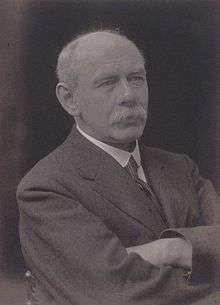Keighley by-election, 1918
The Keighley by-election, 1918 was a parliamentary by-election held for the House of Commons constituency of Keighley in the West Riding of Yorkshire on 26 April 1918.
Vacancy
The by-election was caused by the death on 16 March 1918 of the sitting Liberal MP, Sir Swire Smith.[1]
Electoral history
The most recent contest in the constituency had seen a three-way battle;
| Party | Candidate | Votes | % | ± | |
|---|---|---|---|---|---|
| Liberal | Sir Stanley Owen Buckmaster | 4,730 | 38.7 | ||
| Unionist | Viscount Lascelles | 3,852 | 31.5 | ||
| Labour | William Bland | 3,646 | 29.8 | ||
| Majority | 878 | 7.2 | |||
| Turnout | 86.5 | ||||
| Liberal hold | Swing | ||||
Candidates
Keighley Liberals chose William Somervell, a 39-year-old director of his family business, Somervell Bros. of Kendal, leather merchants and boot manufacturers, later known as K Shoes as their candidate. Somervell had twice previously contested the South or Kendal Division of Westmorland for the Liberals.[2][3]
As the by-election was taking place during wartime and Somervell was standing as the candidate of the Coalition government he did not face Conservative or Labour Party opponents. There was however a ‘Peace by Negotiation’ candidate, William Bland, (who is also referred to in some reference books as an ILP candidate) and who had been the official Labour candidate at a previous contested by-election in the constituency in 1913.[4] At one point too it looked as if there would be a woman candidate in the field. Nina Boyle, a journalist and well-known campaigner for women's suffrage and women's rights made known her intention to put up at the by-election as a candidate of the Women's Freedom League. Although women over thirty gained the vote in 1918, there was some doubt as to whether women were eligible to stand as parliamentary candidates. Boyle announced that she would test the law and if her nomination was refused would take the matter to the courts to obtain a definitive ruling.[5] After some legal consideration, the Returning Officer stated that he was prepared to accept her nomination, thus establishing an important precedent for women candidates. However he ruled her nomination papers invalid on other grounds. One of the signatories to her nomination was not on the electoral roll and another lived outside the constituency. While Boyle did not therefore get to appear on the ballot paper, she claimed a moral victory for women’s suffrage rights [6] and cleared the way for others to stand and win election a few months later at the 1918 general election.
Result

Somervell was returned easily with a majority of 2,524 votes and well over 50% of the poll.[7]
| Party | Candidate | Votes | % | ± | |
|---|---|---|---|---|---|
| Liberal | William Henry Somervell | 4,873 | 67.5 | +28.8 | |
| Ind. Labour Party | William Bland | 2,349 | 32.5 | +2.7 | |
| Majority | 2,524 | 35.0 | +27.8 | ||
| Turnout | 50.2 | -36.3 | |||
| Liberal hold | Swing | +13.0 | |||
Historians have argued that this was an indication of a growing and substantial body of public opinion favouring a negotiated peace settlement with Germany following the publication of the Lansdowne letter and an increasing sign of war-weariness.[8]
Aftermath
Somervell and Bland faced each other again at the General Election 8 months later. However, this time a Unionist also stood and received official endorsement of the Coalition Government, helping him secure victory;
| Party | Candidate | Votes | % | ± | |
|---|---|---|---|---|---|
| Unionist | Sir Robert Clough | 8,820 | |||
| Liberal | William Henry Somervell | 7,709 | |||
| Labour | William Bland | 6,324 | |||
| Majority | 1,111 | ||||
| Turnout | |||||
| Unionist gain from Liberal | Swing | ||||
See also
- List of United Kingdom by-elections
- United Kingdom by-election records
- Keighley by-election, 1913
- Keighley by-election, 1915
References
- ↑ Asa Briggs, Sir Swire Smith in Oxford Dictionary of National Biography, OUP 2004-09
- ↑ The Times House of Commons, 1911; Politico’s Publishing, 2004 p91
- ↑ The Times, 18 March 1913 p8
- ↑ F W S Craig, British Parliamentary Election Results, 1885-1918; Macmillan Press, 1974 p438
- ↑ The Times, 4 April 1918 p. 3
- ↑ The Times, 10 April 1918 p. 3
- ↑ The Times, 29 April 1918 p5
- ↑ Roy Douglas, Background the 'Coupon' election arrangements; English Historical Review, Vol 86, No 339, April 1971 pp318-336